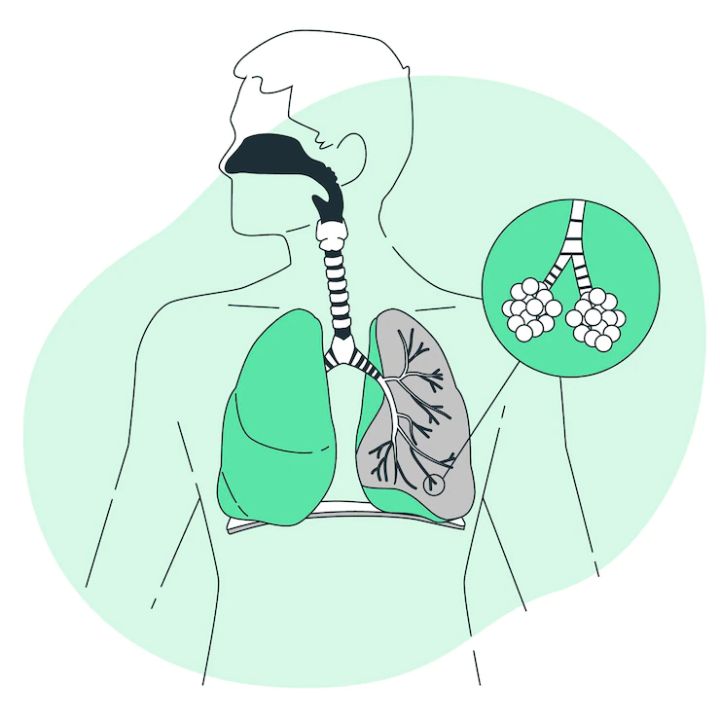Respiratory physiotherapy plays a crucial role in managing various respiratory conditions, including chronic obstructive pulmonary disease (COPD), asthma, bronchiectasis, and cystic fibrosis. Respiratory physiotherapy can help improve lung function, reduce symptoms, and enhance overall lung health by focusing on breathing exercises, respiratory therapy techniques, and respiratory muscle training.
COPD is a progressive respiratory disease that affects millions of people worldwide. It causes airway inflammation, resulting in shortness of breath, coughing, and wheezing. Physiotherapy can help reduce symptoms and improve exercise tolerance in COPD patients by targeting breathing techniques, such as pursed-lip breathing, and respiratory muscle training.
Asthma is another common respiratory condition that can benefit from physiotherapy. It is characterized by recurrent episodes of wheezing, coughing, and shortness of breath. Respiratory physiotherapy can help asthma patients improve their breathing control, reduce airway hyperresponsiveness, and increase their exercise capacity through breathing exercises and other techniques.

Photo Credit: stefamerpik
Bronchiectasis is a chronic lung condition that results in the widening and scarring of the airways. Respiratory physiotherapy interventions, such as airway clearance techniques, can help bronchiectasis patients clear mucus from their airways, reduce coughing, and improve their lung function.
Cystic fibrosis is a genetic disorder that affects the lungs, pancreas, and other organs. Respiratory physiotherapy is an integral part of the treatment plan for cystic fibrosis patients, as it can help them clear mucus from their lungs, prevent infections, and improve their overall lung function.
Overall, respiratory physiotherapy is an effective intervention for managing various respiratory conditions. By targeting breathing techniques, respiratory therapy techniques, and respiratory muscle training, physiotherapy can improve lung function, reduce symptoms, and enhance overall lung health.
Respiratory physiotherapy involves a range of methods and techniques that aim to improve lung function, reduce shortness of breath, and enhance overall respiratory health.
Breathing exercises are a fundamental part of respiratory physiotherapy. They involve targeted breathing patterns and techniques that aim to improve lung capacity, reduce breathlessness, and enhance overall respiratory function.
Common breathing exercises include pursed-lip, diaphragmatic, and deep breathing. In addition, physiotherapists may use incentive spirometry, which involves the use of a special device to encourage deep breathing and improve lung function.
Manual techniques involve physically manipulating the chest and lungs to improve respiratory function. These techniques may include chest percussion, which involves the rhythmic tapping of the chest wall to help loosen and clear mucus from the lungs.

Photo Credit: Racool_studio
Physiotherapists may also use vibration therapy, which involves the use of a special device to vibrate the chest wall and help move mucus out of the lungs. Other manual techniques may include postural drainage, which involves positioning the body to allow mucus to drain from the lungs.
Respiratory muscle training involves exercises designed to strengthen the muscles used in breathing. These exercises may include deep breathing, yoga, and resistance breathing using a special device. Stronger respiratory muscles can improve lung function and reduce breathlessness in individuals with respiratory conditions.
Airway clearance techniques are methods used to help clear mucus from the lungs. These techniques may include active cycle of breathing technique, huff coughing, and forced expiration technique. Airway clearance techniques can help prevent respiratory infections and improve lung function.
Respiratory physiotherapy involves various methods and techniques that aim to improve respiratory function and enhance overall lung health. By using a combination of these interventions, physiotherapists can develop a comprehensive treatment plan that is tailored to individual patient needs.
Respiratory physiotherapy is a proven method of managing respiratory conditions and improving respiratory function. Across a range of respiratory conditions, patients can benefit from physiotherapy interventions.
One of the primary benefits of respiratory physiotherapy is improved lung function, which leads to better respiratory outcomes. A comprehensive physiotherapy treatment plan may include breathing exercises, airway clearance techniques, and respiratory muscle training, all of which can help improve lung function.

Photo Credit: storyset
Specifically, these interventions can improve vital capacity, the amount of air that can be exhaled after maximal inhalation. By improving vital capacity, respiratory physiotherapy can help individuals with respiratory conditions breathe more easily and comfortably.
Shortness of breath, also known as dyspnea, is a common symptom of many respiratory conditions. Respiratory physiotherapy can help reduce shortness of breath by improving respiratory function and exercise tolerance.
Through the use of breathing exercises and respiratory muscle training, individuals can learn to breathe more efficiently and use their respiratory muscles more effectively. This can help to reduce the sensation of shortness of breath and improve overall respiratory function.
For individuals with respiratory conditions, exercise can often be a challenge. However, regular exercise is important for maintaining respiratory function and overall health.
Exercise tolerance and endurance can be improved by incorporating respiratory physiotherapy into an individual’s treatment plan. Through the use of respiratory muscle training and breathing exercises, individuals can learn to breathe more efficiently during physical activity and tolerate exercise for longer periods of time.
By improving respiratory function, reducing shortness of breath, and enhancing exercise tolerance, physiotherapy can significantly impact an individual’s quality of life.
Individuals with respiratory conditions may experience limitations in daily activities and reduced overall health-related quality of life. Respiratory physiotherapy interventions can reduce the impact of these limitations, allowing individuals to engage in activities of daily living more easily and enjoy a better quality of life.

Photo Credit: Freepik
Respiratory physiotherapy is an effective and important method of managing respiratory conditions and improving respiratory function. With a comprehensive treatment plan that includes a range of interventions, individuals can experience significant improvements in lung function, reduced shortness of breath, enhanced exercise tolerance, and an improved quality of life.
Respiratory physiotherapy is a specialized form of physiotherapy aimed at improving respiratory function and reducing symptoms in individuals with respiratory conditions. If you’re considering physiotherapy, you may have some questions about how it works and what to expect. Here are some frequently asked questions about respiratory physiotherapy:
Respiratory physiotherapy can benefit individuals of all ages who have respiratory conditions such as chronic obstructive pulmonary disease (COPD), asthma, bronchiectasis, and cystic fibrosis, among others. It can also benefit individuals who have undergone respiratory surgery or those who are experiencing shortness of breath due to other medical conditions.
The duration of respiratory physiotherapy treatment can vary depending on the severity of the respiratory condition and the individual’s response to treatment. Treatment plans can range from a few sessions to several months, and may involve ongoing maintenance to sustain the benefits achieved from the treatment.
Respiratory physiotherapy involves various techniques aimed at improving respiratory function and reducing symptoms. These may include breathing exercises, airway clearance techniques, respiratory muscle training, and exercise programs to improve overall fitness. The techniques will be tailored to the individual’s needs and goals.
Yes, physiotherapy can be beneficial for children who have respiratory conditions. Paediatric respiratory physiotherapists are trained to work with children and adjust treatment methods to suit their unique needs and development.
This will vary depending on the type of health insurance you have. Some private health insurance plans may cover respiratory physiotherapy, while others may require a referral from a doctor. It’s important to check with your health insurance provider to confirm if this form of treatment is covered under your plan.
Respiratory physiotherapy can be an effective tool in managing respiratory conditions and improving overall lung health. By addressing common concerns and questions, individuals can make informed decisions about pursuing this treatment option.